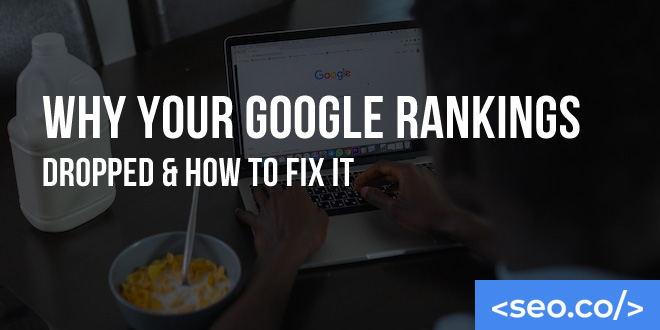
Why Your Google Rankings Dropped & How to Fix It
A significant and sudden drop in your Google rankings can can be both frustrating and frightening. It’s especially terrifying if you have no idea why your Google rankings dropped so suddenly. With over 200 Google ranking factors, there are a multiplicity of reasons why a site’s Google ranking might suffer an abrupt plunge. If your Google rankings dropped overnight, don’t worry, it doesn’t have to be permanent. Luckily, a majority of Google rankings issues can be remedied with a bit of time and effort. Although, if your Google rankings drop overnight, it can sometimes take months of heavy work to fully recover the lost ground. But, don’t despair! Recovery from a sudden drop in Google rankings is possible! Let’s look at some of the most common issues that could cause a site’s search engine ranking to plummet AND how you might fix them. Your Website is New(ish) The number one issue we see when it comes to drops is typically related to new websites. New sites get a lot of love from Google. And a lot of hate. It’s complicated. When your site launches, Google will have never heard of it, and it won’t have your site indexed, which means you can’t show up in any search results. When Google first indexes your site, the Google algorithm might give you an artificial ranking boost (since Google’s algorithm naturally favors new sites temporarily), leading you to believe you’ve earned those ranks all on your own. After that introductory period, your rankings will probably drop again as Google tries to make better sense of who you are and how authoritative you are. If your site is less than five years old, chances are there will be much more volatility than other established websites. To put it concisely, volatility (a.k.a. Google dancing, which we discuss a bit more in detail below) is expected and normal for new sites. You’re Not Diversified in Your Google Ranking Factors The second most common reason for a Google rankings drop is an over-focus on one ranking factor to the exclusion of all others. For instance, it is possible to have too many internal links and over-optimized content. Did you know that the most important Google ranking factor is diversity of the overall factors? It’s not backlinks! So, when a site focuses too much of their SEO efforts on building backlinks, to the exclusion of other factors, they are more likely to see a drop in their rankings. Excessive backlinks (particularly if they are not natural or diverse enough) can look like unnatural links to Google, which might be a factor if your Google ranking dropped dramatically. We cover this in more detail in our complete list of the most statistically significant Google ranking factors. Canonicalization Issues Problems with canonicalization are somewhat similar to issues with duplicate content. These problems crop up when Google has indexed a page from your site with multiple different URLs. Canonicalization issues can occur when two versions of a domain name are indexed or when a single domain name is indexed with both HTTPS and HTTP. Unfortunately, this type of problem is easy to encounter through no fault of your own. Anyone who links to your site with an incorrect version of the URL can cause canonicalization trouble for you. If this happens, it’s important to reach out to the webmaster of the site with the bad link and attempt to have it changed. Host Server Problems Google is typically quite forgiving of short-lived server problems on your site: If your website is down for maintenance or experiences a day or two of availability problems, your ranking should be unharmed. However, if the webcrawlers have trouble accessing your site for several days, it could have a negative impact on your ranking. If you’re planning to take your site down for maintenance, you should make changes on your server so that a 503 code is generated; this indicates to the outage is temporary. Detection of Malware The presence of malware on your site won’t directly harm your ranking, but the impact it has on the traffic you get from search results is just as significant. If Google observes the presence of malware on your site, it will add a warning for users next to your listing in the search results. If the problem becomes too extensive, Google may blacklist your entire domain. Various tools are available for finding and removing malware on your website. Once you succeed in dealing with the infection, Google will be able to remove the malware warning from your search results listing. Google Updates & Search Algorithm Changes If you’ve been playing by the rules with your website, and your site hasn’t been experiencing any technical problems, your drop in ranking may be due to an algorithm change by the search engines. SEO rankings usually drop after Google algorithm updates and unfortunately, many people experience a dramatic Google ranking drop. In an effort to improve the overall quality of their results, Google and the other engines have made many adjustments to the way they index and rank web content. It’s not just about backlinks and site speed. Google updates and Google Core Updates, in particular, can cause immediate and sudden changes to Google rankings, regardless of the industry. It’s hard to find a business owner who hasn’t been impacted by a Google algorithm update ranking drop. Take a gander at any Google search sensor to tell whether or not major flux is occurring: While most of these algorithm tweaks result in a more gradual impact on rankings, an overnight rankings drop could occur if your site is particularly affected by the changes. If this happens to your site, your only recourse is to work on improving your website’s SEO and attempt to make your website stronger and better. The most likely culprit to an overnight Google rankings drop is actually the simplest explanation. Google has released a new algorithm update or a new data refresh that reevaluated the rankings







